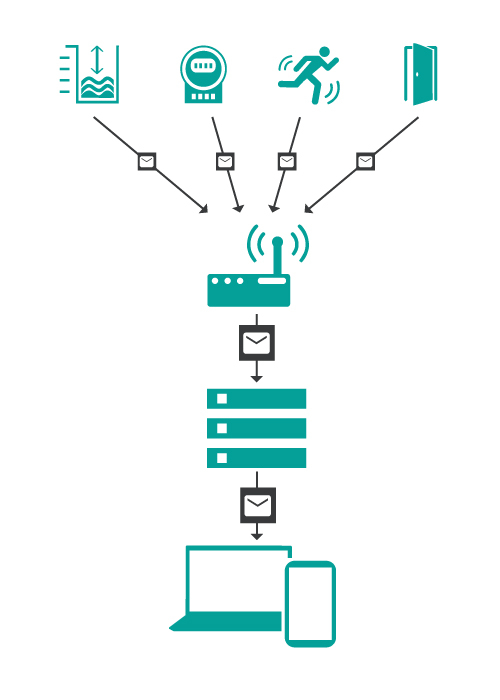What is LoRaWAN?
LoRaWAN (Long Range Wide Area Network) is a special technology for the Internet of Things (IoT) that makes it possible to transmit data over long distances with low energy consumption. This makes it ideal for applications where devices are distributed over wide areas and only need to send data infrequently, such as in agriculture or urban infrastructure networks.
Typical use cases for LoRaWAN

Smart City
Street lighting, traffic tracking and other remote monitoring systems
Environmental monitoring
Monitoring of air and water quality, as well as the groundwater level

Smart Village
Transformer station monitoring, street lighting and other remote monitoring systems

Industrial IoT (IIoT)
Monitoring systems and machines
Smart Agriculture
Monitoring soil moisture and weather conditions
Building digitalisation
Control and monitoring of HVAC systems and energy management
LoRaWAN in comparison with other technologies
LoRaWAN is particularly advantageous in applications where long range and low energy consumption are required, but where a high data transmission rate is not needed. Compared to technologies such as 5G, NB-IoT or Zigbee, LoRaWAN offers a simpler and often more cost-effective solution for use cases that require wide geographic coverage and long battery life, but only transmit small amounts of data.

The advantages of LoRaWAN
Open standards and flexibility LoRaWAN is based on open standards defined by the LoRa Alliance. This openness promotes interoperability between devices from different manufacturers and supports a broad developer community. Companies can choose from a wide range of hardware and network options and are not tied to a specific provider.
Customisable network options: A key benefit of LoRaWAN is its flexibility in network configuration. Organisations can set up private LoRaWAN networks that are completely under their control, or they can use public networks managed by third-party providers. This flexibility enables a customised balance between cost, coverage and security requirements.
Cost efficiency: Compared to other LPWAN technologies, LoRaWAN can be more cost-effective, especially when it comes to building private networks. Costs are often lower than cellular-based LPWAN solutions such as NB-IoT and LTE-M, as there are no ongoing network access fees or licence costs.
Overall, LoRaWAN is particularly advantageous for use cases where long range, long battery life and cost efficiency are important, while a high data transmission rate is less critical.
Is LoRaWAN the right technology for you?
Feel free to contact us if you would like to discuss your specific application conditions and find out which IoT technology is best suited to your requirements.
Limitations of LoRaWAN technology
Limited data rate: LoRaWAN is designed for low data rates (typically between 0.3 kbps and 50 kbps), which limits the transmission of large amounts of data or use in real-time applications.
Capacity limitations: Despite the high number of devices a gateway can support, there are limitations on the number of messages a device can send per day, especially on public networks.
Interference and range issues in cities: In urban areas, buildings and other structures can attenuate the signal and reduce the effective range.
Network management: Managing a private LoRaWAN network requires technical expertise and resources, especially when it comes to network scaling and security.

Which LoRaWAN sensors are available?
In our online shop iot-shop there is a large selection of hardware with LoRaWAN technology. Whether you are looking for a sensor, gateway, actuator or a bridge, we have something for everyone - take a look around and see for yourself!

